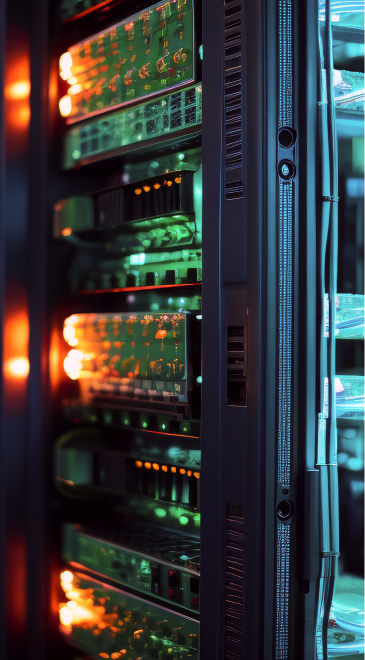What is decentralized finance (DeFi)?
There’s no escaping it: the phenomenon of Decentralized Finance, or DeFi, is sweeping the world.
For some, it’s the future of finance, nothing more, nothing less.
For others, it’s a freewheeling financial system that offers as many guarantees as a ship set adrift.
In fact, what is sometimes referred to as "DeFi crypto" – so closely linked is it to the world of crypto-currencies – is an extremely solid foundation on which many financial transactions are already taking place in complete security.
And it’s all thanks to the famous DApps that underpin the way DeFi works.
Definition of a decentralized financial system
Decentralized Finance (DeFi) is an innovative financial infrastructure that does not rely on a central bank or government agencies to operate.
But what exactly is a decentralized financial system?
It’s an ecosystem in which transactions don’t need to be validated by intermediaries, since they’re based on blockchain technology (and the principle of the smart contract), peer-to-peer, i.e. person-to-person: no official entity holds control or can modify the transactions carried out.
This decentralized finance infrastructure encompasses a range of dedicated applications (known as "DApps") that offer a variety of services to individuals and businesses: obtaining loans, transferring money worldwide, investing savings or stock market investments, Yield Farming, and so on.
These applications form the cornerstone of this decentralized platform, so much so that the decentralized financial system is sometimes defined as all DApps based on blockchain and smart contracts.
The advantage is that the process is highly accessible.
Today, offering financial products or financing solutions is a real challenge, as you need to apply for approval as a credit institution from the ACPR and the Banque de France, have capital of several million euros and arm yourself with both patience and solid legal backing.
Thanks to DeFi, this is no longer necessary: decentralized applications make it possible to exchange, lend and trade without intermediaries.
Anyone can act as an exchanger, lender or supplier of cash.
DeFi and crypto: two inseparable concepts
Originally, the concept of a decentralized financial system comes from the world of cryptocurrencies – which is why the terms "crypto" and "DeFi" are often used in conjunction, since DeFi uses crypto to exist.
The majority of Decentralized Finance services are linked to the Ethereum network, which is second only to Bitcoin as the most important cryptocurrency marketplace – and the one that launched the principle of decentralized finance.
Today, in 2023, the main blockchains offer decentralized finance services: Near Protocol, Fantom, Solana, Avalanche…
In 2013, Russian-Canadian Vitalik Buterin wrote a document describing an open source platform enabling programmers to imagine their own applications: this was the birth certificate of the DeFi crypto.
This decentralized platform is designed so that other blockchain-like applications can be developed on the same network, making it possible to offer ever more services linked to decentralized finance.
How does DeFi (decentralized finance) work?
How DeFi (Decentralized Finance) works is linked to cryptocurrencies, which are themselves based on blockchain and smart contracts.
DeFi relies on crypto and the smart contract principle to offer financial services independently of any intermediary.
To take advantage of the decentralized financial system, users go through DApps applications that offer them peer-to-peer services, i.e. from individual to individual, but via cryptocurrency wallets.
Owners of crypto-currencies (Bitcoin, Ethereum, etc.) can access financial services and products without having to go through traditional banks, without having to provide receipts, and without having to open an account.
They can negotiate money loans (using a smart contract), buy derivatives (futures and other products in DeFi crypto versions), immobilize cryptocurrencies to earn interest in the form of rewards (" staking "), which amounts to saving at more attractive rates than those offered by banks… And, of course, buy cryptocurrency (tokens, coins such as Ether or Solana, etc.), purchase USDT or carry out peer-to-peer transactions.
As for the development of DApps, it’s free: decentralized finance protocols are open and applications are open source.
Anyone can develop an application on the DeFi crypto, and any user can inspect their code at any time, or even make improvements.
This openness of the DeFi crypto encourages emulation among developers, and ultimately innovation.
The role of smart contracts in blockchain
DeFi crypto relies on blockchain and smart contracts to operate.
But what exactly is a smart contract?
Smart Contracts are contracts stored in the blockchain, executed automatically, and peer-to-peer, when conditions specified upstream are met.
Each contract is a computer code that serves as an agreement between two parties: it is therefore sent without the intervention of a third party.
In short, smart contracts enable transactions to be carried out peer-to-peer, without the intervention of an intermediary.
This technology eliminates the need for collateral or insurance – in the case of a loan, for example.
This is true for all types of transaction in DeFi, which is why smart contracts are so present in the ecosystem of decentralized finance.
What is the aim of DeFi (decentralized finance)?
Today, decentralized finance is just a drop in the ocean of traditional finance.
Its complexity for users and its readily obscure language(DeFi for "Decentralized Finance", DEX for "decentralized exchanges", DApps for "decentralized applications", blockchain, staking, liquidity pool…) still act as repellents for private individuals.
As a result, DeFi remains difficult to grasp, even though it is becoming increasingly easy to access, since all you have to do is connect to an exchange platform (like Coinhouse!) to buy cryptocurrency and use decentralized financial services.
DeFi, an ecosystem at the service of users
These difficulties encountered by decentralized finance among the general public are somewhat ironic, given that DeFi was born of the ambition to give citizens back control of their financial destiny.
Indeed, the original aim of DeFi crypto lies in this notion of freedom that users could enjoy by regaining their independence from financial institutions and private bodies that put up barriers, dictate their conditions, and don’t hesitate to exclude certain profiles.
In this way, DeFi envisions a world where finance is inclusive, in the sense that it leaves no one behind.
For example, obtaining a loan via a decentralized application turns out to be much simpler, since the transaction doesn’t depend on the goodwill of a bank.
All you need to do is hold cryptocurrencies to use such an application and free yourself from the shackles created by financial institutions.
The future of DeFi crypto
The aim of Decentralized Finance, or DeFi, is not to replace the traditional financial system.
What it does aim to do is offer an alternative to market players (particularly individual borrowers and investors), enabling them to manage their cash or investments simply and securely, outside the constraints imposed by financial institutions.
So far, it’s hard to talk of a DeFi crypto revolution, as it remains the preserve of a happy few.
However, the characteristics of decentralized finance give it real disruptive potential.
In a few years’ time, we can imagine a world in which the majority of transactions will be processed via blockchain and smart contracts.
Indeed, despite the fears expressed by market players, billions of dollars are being injected into DeFi protocols every year.
The digital transformation of finance has undoubtedly only just begun!
The advantages of decentralized finance
Using DeFi crypto offers many advantages for individuals and businesses alike.
What are they?
DeFi or decentralized finance: a financial ecosystem accessible to all.
This is undoubtedly the most important feature of DeFi crypto: this financial ecosystem is open to all.
Decentralized finance applies no restrictions, it doesn’t discriminate between users, and it doesn’t impose obscure rules that favor the better endowed and prevent the more modest from accessing financial services.
Whereas the traditional banking system excludes some individuals and businesses, for example when it comes to granting loans or offering investments at attractive interest rates, DeFi crypto shines, on the contrary, through its accessibility.
In this sense, it is a lever for reducing financial inequality, as transactions are not dependent on bank decisions or obligations imposed by financial authorities.
Instant, secure financial transactions
It would be an understatement to say that the fears of traditional market players with regard to DeFi crypto are unfounded: decentralized finance offers a framework that is both more secure, more transparent and more efficient than the conventional financial environment.
The level of security enabled by blockchain is extremely high: financial transactions cannot be modified or altered.
Smart contracts help automate financial services, resulting in instantaneous transactions and valuable time savings for investors.
In short, the robustness of DeFi’s protocols cancels out risk for all players in the system, while making exchanges more efficient and swifter.
DeFi crypto, a neutral technology
By removing the human factor from the equation, decentralized finance achieves an optimal level of neutrality.
In so doing, DeFi crypto identifies and prevents illegal or unfair practices – financial scams, fraud, insider trading… – while at the same time providing maximum visibility over transactions and their progress.
It also reduces the risk of human error.
Not everything is perfect, of course: while offering guarantees, DeFi crypto is not risk-free.
For example, it’s important to bear in mind that some decentralized finance protocols are embedded in their native token, and therefore subject to changes in the token’s price – a sudden drop in value could have a negative effect on the applications associated with it.
All in all, however, it remains a solid and highly secure tool.
MakerDAO: the primary market
What is MakerDAO?
The world of DeFi, or "Decentralized Finance", came into being with the MakerDAO app in December 2017.
This app launched its own virtual currency, the DAI, a stablecoin: a currency whose value is stable, always equal to the dollar, whatever the circumstances.
So that 1 DAI is constantly worth 1 dollar, 10 DAIs are worth 10 dollars, and so on.
However, the DAI is not directly indexed to a reserve of dollars, but based on a reserve of crypto-currencies, with indexation to the dollar provided by a different – and complex – mechanism.
The advantage?
In an ecosystem subject to wide fluctuations, with crypto-currencies reaching peaks only to collapse a few days later, stablecoin offers welcome stability.
MakerDAO is hosted on the Ethereum blockchain.
The protocol is now fully decentralized, making it one of the first to achieve this on the Ethereum network: the Maker community is responsible for all facets of the protocol.
This means that future development of the protocol will be determined by members of the community.
DAI and the primary market
DAI is the foundation of decentralized finance, or DeFi crypto.
MakerDAO positions itself as the primary market for issuing money, and the neo-platforms take the place of a secondary market for making this money supply available.
This is reminiscent of the workings of a central bank and commercial banks, with these new players replicating elements familiar from the world of finance.
It is on this primary market that players meet and exchange new values.
Since 2019, MakerDAO has launched a new protocol (Multi-collateral DAi) that enables it to accept exchanges with tokens other than ETH.
The variable guarantee values are decided within the framework of the protocol’s governance, itself made possible by the other token issued by MakerDAO: the Maker (MKR).
These are the pillars of DeFi crypto.



























